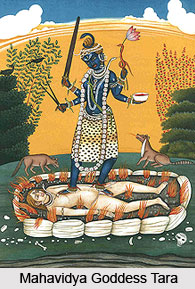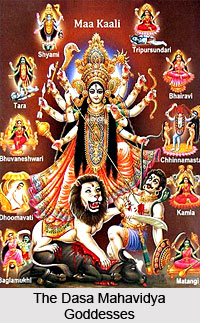 Mahavidyas or Great Wisdoms are aspects of Ten Devis in Hindu mythology. These Mahavidya Goddesses are also called Dasa Mahavidyas or Wisdom Goddesses. The range of these Mahavidya Goddesses covers the whole range of feminine divinity, encircling horrific goddesses at one end, to the astonishing beautiful Devis at the other. The term Mahavidya comes from the root of maha (great) and vidya (revelation, expression, knowledge, wisdom). In the Tantric tradition.
Mahavidyas or Great Wisdoms are aspects of Ten Devis in Hindu mythology. These Mahavidya Goddesses are also called Dasa Mahavidyas or Wisdom Goddesses. The range of these Mahavidya Goddesses covers the whole range of feminine divinity, encircling horrific goddesses at one end, to the astonishing beautiful Devis at the other. The term Mahavidya comes from the root of maha (great) and vidya (revelation, expression, knowledge, wisdom). In the Tantric tradition.
The Mahavidya Goddesses are identified as the following -
| Kali |
Bhuvaneshvari |
Bhairavi |
| Tara |
Tripura Sundari |
Dhumavati |
| Chhinnamasta |
Bagalamukhi |
Matangi |
| Kamalatmika |
|
|
The Mahabhagavata-purana and Brhaddharma-purana provide a slightly varied list of the Mahavidyas, namely Kali, Tara, Bhuvanesvari, Chinnamasta, Bagala, Kamala, Dumavati, Sodasi, Matangi, and Bhairavi. The Guhyatiguyha - tantra associates the Mahavidya Goddesses with the ten avatars of Vishnu, and states that the goddesses are the source from which the avatars of Vishnu arose.
All ten forms of the Mahavidya Goddesses, whether gentle or terrifying, are worshiped as the universal Mother. The evolution of the Mahavidya Goddesses in Hindu mythology is related to a game event between Shiva and Parvati. Once during a game of dice, things went out of hand between Shiva and Parvati. Shiva lost the game, and Parvati asked for the crescent moon, which ornaments his hair, as payment. When he refused, she was enraged. The game that had started in jest turned into a serious matter with an infuriated Shiva threatening to walk out on Parvati. No amount of cajoling by Parvati could overturn matters. Left with no choice, Parvati multiplied herself into ten different forms for each of the ten directions thus blocking the way of Shiva.

Each of the Parvati`s manifested forms made Shiva realize the essential truths and made him aware of the eternal nature of their shared love. Shiva was spiritually awakened after seeing this sight. Thus the Mahavidya Goddesses or the Great Goddesses of Wisdom were born. Indeed in the process of spiritual learning, the Mahavidya Goddesses are the muse who guides and inspires the mortal beings. Mahavidya Goddesses are the highest priestess who unfolds the inner truths.
Another popular story related to the Mahavidya Goddesses that is told in several Puranas, involves an argument between Shiva and Sati or the Dakshayani, an earlier incarnation of Parvati. When Shiva and Sati were wed, Sati`s father Daksha condemned the match and organized a great sacrifice to which he invited everyone except for the newlywed couple. Sati, annoyed, insisted on attending the sacrifice, which Shiva forbade until Sati transformed herself into a terrible appearance and multiplied into the ten Mahavidyas, thus she subdued Shiva`s resistance and attended the sacrifice.
The Dasa Mahavidya Goddesses are strongly associated with death, violence, ritual pollution, and despised marginal social roles. The worship of these goddesses suggests that the devotee experiences an inspirational and liberating spirituality in all that is prohibited by recognized social orders. Mahavidya Goddesses stretches one`s consciousness beyond the conventional, to break away from accepted social norms, roles, and potential.
Each of the Mahavidya Goddesses inspires living one`s life according to rules of purity and pollution, detesting caste and class. Atma in Dasa Mahavidya Goddesses is called as Mother with 10 different names with 10 types of major dimensions. Shiva being in Yoga Nidra appears with his energy like a Beautiful Mother (Nature). When a person`s illusion surrenders to the Mother by any one of the Dasa Mahavidya Goddesses, he will realize that she is none other than Shiva. Shiva externally appears as Mother but internal is Lord Shiva. This is the secret meaning of all Maha Vidyas. It is also important to understand that one who follows these Dasa Mahavidya Goddesses should understand the mind beyond the mundane.
 Mahavidyas or Great Wisdoms are aspects of Ten Devis in Hindu mythology. These Mahavidya Goddesses are also called Dasa Mahavidyas or Wisdom Goddesses. The range of these Mahavidya Goddesses covers the whole range of feminine divinity, encircling horrific goddesses at one end, to the astonishing beautiful Devis at the other. The term Mahavidya comes from the root of maha (great) and vidya (revelation, expression, knowledge, wisdom). In the Tantric tradition.
Mahavidyas or Great Wisdoms are aspects of Ten Devis in Hindu mythology. These Mahavidya Goddesses are also called Dasa Mahavidyas or Wisdom Goddesses. The range of these Mahavidya Goddesses covers the whole range of feminine divinity, encircling horrific goddesses at one end, to the astonishing beautiful Devis at the other. The term Mahavidya comes from the root of maha (great) and vidya (revelation, expression, knowledge, wisdom). In the Tantric tradition.
 Each of the Parvati`s manifested forms made Shiva realize the essential truths and made him aware of the eternal nature of their shared love. Shiva was spiritually awakened after seeing this sight. Thus the Mahavidya Goddesses or the Great Goddesses of Wisdom were born. Indeed in the process of spiritual learning, the Mahavidya Goddesses are the muse who guides and inspires the mortal beings. Mahavidya Goddesses are the highest priestess who unfolds the inner truths.
Each of the Parvati`s manifested forms made Shiva realize the essential truths and made him aware of the eternal nature of their shared love. Shiva was spiritually awakened after seeing this sight. Thus the Mahavidya Goddesses or the Great Goddesses of Wisdom were born. Indeed in the process of spiritual learning, the Mahavidya Goddesses are the muse who guides and inspires the mortal beings. Mahavidya Goddesses are the highest priestess who unfolds the inner truths.




















